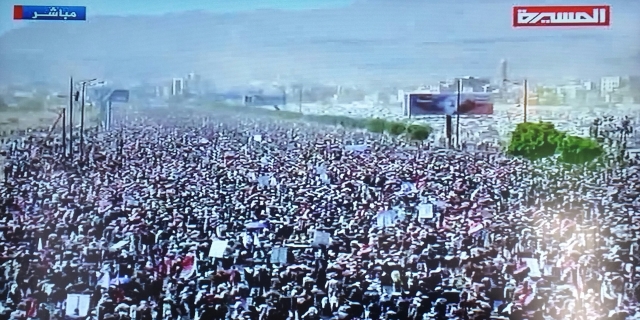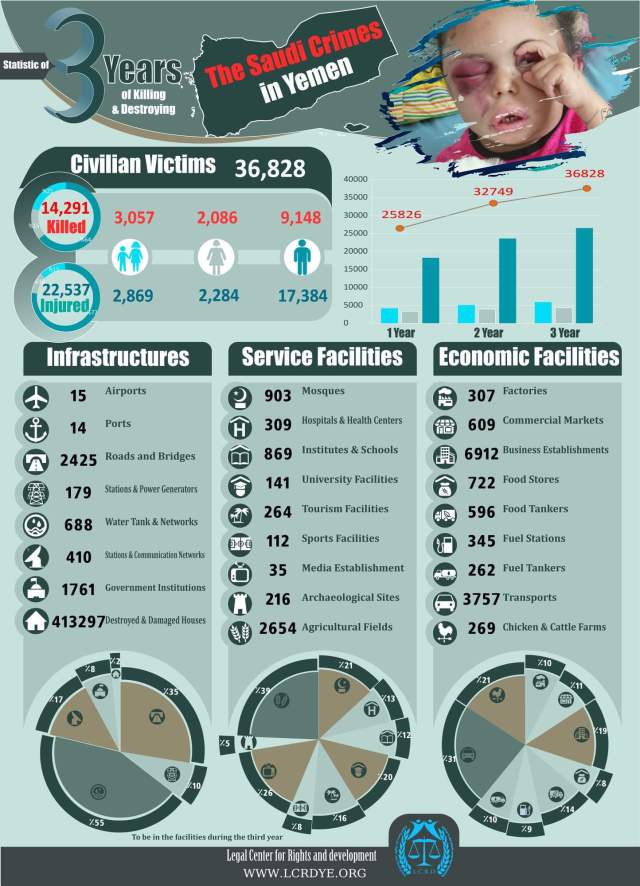Three Years of Sanctioned Genocide
Part I: Prelude to War


By: Hassan Al-Haifi
Introduction
On the evening of 26th March 2015, then Ambassador Adil Al-Jubeir of Saudi Arabia to Washington (now Foreign Munister of KSA) held a haunting press conference in Washington with mysterious underpinnings. Jubair went on to tell the entire world (http://mobile.abc.net.au/news/2015-03-26/saudi-arabia-launches-military-operation-in-yemen/6349454) that his country is leading a Coalition of 10 mostly super wealthy other Arab and non-Arab countries were about to wage a War on Yemen, probably the poorest country of the region, if not the world. This war was to be another hauntingly disastrous and grossly inhumane element of Saudi Arabia’s good neighbor policy, which has been travic for countries like Iraq, Syria, Somalia, Sudan and Bahrain. Unlike the Saudi interventions in most countries in the area, Jubeir was talking about a round-the-clock direct bombing campaign to supposedly disarm Yemen and a tight siege by US and UK warships. The aim of this oddball configuration of belligerants against the Republic of Yemen is to “return the (actually il-) legitimate President, Abdu Rabbo Mansour Hadi to the Presidential Palace in Sana’a”, Jubeir told the quickly gathered news conference. Why such a big fuss about a mostly drunken President (see https://m.youtube.com/watch?v=NgynPKRI1xg), who has given Yemen 3 years of awful government after being spoon-fed to the Yemeni people to replace his former dictator boss Ali Abdullah Saleh, who hence has ruled Yemen for a third of a century from July 7, 1978 to February 2012. Then Vice President Hadi had been elected (no competetors) to a temporary two year term until full national elections are held and a new government set up to replace the awesomely corrupt and bureaucratic nightmare of the Saleh Government machine. Hadi and the other side of the Saleh Regime [Al-Ahmar family of Sheikh of Hashid Tribe, Al-Ahmar relatives of Saleh in the military, and the Islah Wahhabi (Yemen Congregation of Reform) Party) all were joined together to form this new temporary regime accordingg to a Gulf Cooperation Council Initiative to boot Yemen out of an Arab Spring uprising started a year earlier in February 11, 2011. Bear in mind here that the most archaic regimes (led by Saudi Arabia) came out with a solution to a popular uprising against the long-time stooge of Saudi Arabia, Ali Abdullah Saleh. (See http://www.merip.or! /mer/mer273/breakdown-gcc-initiative for an understanding of why GCC Initiative broke down).
Background
Ali Abdullah Saleh assumed power in North Yemen prior to unifucation, when military tanks surrounded the Constituent Assembly (acting Parliament) premesis to “elect” then Major Saleh to the Pesidency of the Yemen Arab Republic (YAR). His predecessor, the late Colonel Ahmed Al-Ghashmi was blown to pieces by a suitcase bomb delivered to his office three weeks earlier. Ghashmi was a front put up by Saleh and his co-conspirators (with the Saudis behind the scenes) to absorb the shock of the cold blooded murder of the late very popular Col. Ibrahim Al-Hamidi. Al-Hamidi took over as President in 13th June 1974, in a bloodless coup d’etat (ironically with Saudi prodding) against Yemen’s only civilian government since the Revolution of 26th September 1962, which toppled the monarchy. The Saudis and the traditional tribal ruling establishment in Yemen could no longer stomach Hamidi’s popular agenda and increasing coziness with the Government of South Yemen [People’s Democratic Republic of Yemen, (PDRY), a Marxist leaning headache for the Sheikhs and Kings of the Persian Gulf and the West], which adopted a pro Soviet Marxist agenda. Saleh also became President of united Yemen in 22 May 1990 when YAR and PDRY merged to become the Republic of Yemen.
UN Envoy Jamal Bin Omer and National Dialogue
On August 1, 2012, the Secretary General of the United Nations, Ban Ki Moon appointed Jamal Bin Omer as Undersecretary General and Special Advisor on Yemen to engineer a political settlement and prevent conflict in Yemen (See ttpss://www.un.org/press/en/2012/sga1365.doc.htm).
During the two year transition period, the GCC a Yemeni National Dialogue Conference was convened to get the different Yemeni political factions to agree on a permanent framework for government in Yemen.
The National Dialogue called for by the GCC Initiative got off to a late start on 18th March 2013 and ended on 24 January 2014, with agreemdnt on many aspects of governnent, but still faced disputes on some issues, namely the Houthi Movement of Sa’ada and adjoining governorates (Hajjah, Amran and Al-Jouf) and the Southern Movement. For a good coverage of the difficulties faced during the Transition Period, and the drawbacks in the GCC Initiative, which could be summed up by “the impetus of the initiative was to guarantee the interests of the Yemeni elite and the United States and Saudi Arabia, not implement the changes demanded by the protestors”. See http://www.mei.edu/content/yemens-national-dialogue for further insights into the Transition Period and the National Dialogue and the events leading up to the Yemen Autumn Revolt of September 21, 2014.


So sad what’s happening in Yemen it does break our hearts.
Pingback: The Senseless War on Yemen Three Years of Sanctioned Genocide Part III: Yemen’s Arab Spring/NDC & Transition; September 21, 2014 Revolution | Yemen Common Sense